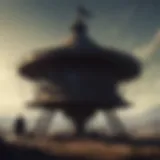Exploring the Fallout Artbook: Visual Narratives
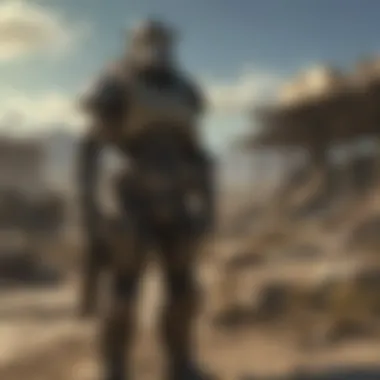

Intro
The Fallout franchise stands out not only for its gameplay and narrative depth but also for its rich visual storytelling. The artbook offers a rare glimpse into the creative minds behind the series' iconic aesthetic. It is more than just a collection of images; it is a window into the ethos that drives the design of a post-apocalyptic world.
Lore Insights
The Fallout universe is a complex tapestry of alternate history, where the remnants of civilization are reshaped by technology and human folly.
Overview of the Fallout Universe
At its core, Fallout explores themes of survival, morality, and humanity in a world ravaged by nuclear war. It contrasts the nostalgic vision of an American utopia with the grim reality of its wastelands. This juxtaposition plays a critical role in shaping the narratives and environments within the games.
Key historical events in the Fallout timeline
Several pivotal moments define the timeline: the Great War of 2077, which obliterated most of humanity, and the subsequent rise of various factions vying for power amid the ruins. The artbook captures these historical touchpoints, offering illustrations that reflect the drastic changes in society and environment post-war. Through artist portrayals, we witness the fall of mega-corporations and the emergence of new ideological groups.
Deep dive into the backstory of major factions and characters
Various factions like the Brotherhood of Steel, the Institute, and the Railroad are integral to the series. Artists have meticulously crafted their designs to encapsulate their unique philosophies and histories. For instance, the Brotherhood's armored soldiers invoke a sense of military might, contrasting sharply with the more secretive and advanced technologies of the Institute. The artbook provides context to their backstories, making it possible to appreciate how visual design complements narrative depth.
"Art can often express what words cannot. In Fallout, the visuals create a depth that enhances the emotional weight of its stories."
Character Analysis
Characters in Fallout are not mere avatars; they embody the intricacies of human interaction and personal journey.
Detailed profiles of iconic characters
Prominent figures like the Sole Survivor, Liberty Prime, and numerous companions display unique character arcs. The artbook dives into their designs and evolution. For example, the dramatic transformation of characters reflects their experiences and choices in the treacherous landscapes of the wasteland.
Relationships between characters in the Fallout series
The relationships among characters add richness to the storyline. For instance, the complex dynamics between companions and the player often reveal more about the game world than the quests themselves. The artbook’s illustrations capture these fleeting moments of connection and conflict, providing a deeper layer to character interactions.
Character development and evolution across games
As players progress through the series, character development takes center stage. Each iteration of the game brings about changes, as seen in the continued growth of characters, influenced by the evolving world around them. The illustrations serve as a visual chronicle of this development, allowing an exploration of how characters adapt to their environment.
The Significance of the Artbook
The Fallout artbook is not only a collection of illustrations but also a crucial narrative device. It juxtaposes visuals with lore, providing players and fans an immersive experience that transcends the confines of traditional gaming. The careful curation of art alongside contextual explanations allows readers to access the intricate connections between artistry and storytelling, bridging the gap between gameplay and conceptual inspiration.
Prelude to the Fallout Artbook
The Fallout artbook serves as a significant contribution to understanding the visual narratives of the franchise. It encapsulates the rich artistic design and creative influences that permeate the world of Fallout. The artbook is more than just a collection of images; it is a critical resource for fans and scholars alike who seek to delve deeper into the artistic essence that shapes the gameplay and storytelling elements. By analyzing this artbook, readers can appreciate how visual art complements narrative structures in video games.
Purpose of the Artbook
The primary purpose of the Fallout artbook is to showcase the stunning illustrations and concept designs that bring the post-apocalyptic world to life. It highlights the vision and intent behind various visual elements, providing insights into the artistic choices made during the development of the game. This documentation also serves as an educational tool, illustrating the process of art creation in gaming.
Furthermore, the artbook offers a window into the minds of the artists and designers who crafted the looks of the iconic characters and immersive environments. Understanding this purpose allows readers to recognize the importance of visual storytelling in game design, indicating how such elements deepen emotional engagement and enhance player experiences.
Overview of the Fallout Franchise
The Fallout franchise is a storied series that has captured the imagination of gamers for decades. It presents an alternate history shaped by nuclear war, where players navigate a diverse array of locations and encounter complex characters. This setting is fundamental for understanding the art created within this universe.
The franchise began with the release of Fallout in 1997 and has evolved through several sequels and spin-offs. Each installment introduces new designs while retaining core themes of survival, moral ambiguity, and societal decay. Art plays a crucial role in establishing the atmosphere, influencing how players perceive the narrative.
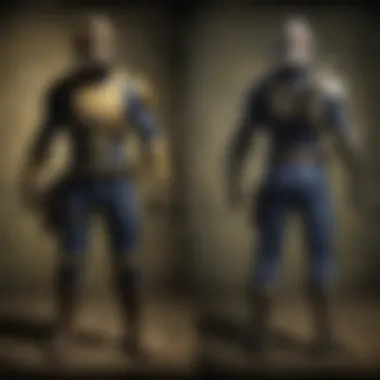

Key themes in the Fallout series include:
- Dystopian Visions: Each game presents a unique interpretation of a society that has collapsed.
- Cultural References: The title is rich with nods to 1950s Americana, adding layers of nostalgia and irony.
- Character Diversity: Players encounter characters from various backgrounds, all of which are visually represented in distinctive styles.
In sum, the Fallout artbook not only showcases beautiful artwork but also encapsulates the complex narratives that have made the franchise a staple in gaming culture.
The Artistic Vision Behind Fallout
The artistic vision behind Fallout is not just a backdrop for gameplay but a crucial element that shapes player experience and engagement. It informs character design, environment aesthetics, and the overarching narrative. Understanding this vision offers insight into how the visual aspects enhance storytelling, create atmospheric depth, and connect with the audience's emotions. Each illustration serves a purpose, conveying themes of survival, nostalgia, and the juxtaposition of a nuclear fallout against vintage Americana. The visual language captures the despair and beauty of a world gone awry, leaving a lasting impact on players.
Influences on Fallout's Art Style
The art style of Fallout is an intricate tapestry woven from various influences. The creators drew heavily from the mid-20th century design, particularly the 1950s American culture, which is characterized by optimism and technological advancement. This era serves as the visual foundation, marrying a retro-futuristic aesthetic with themes of desolation after a catastrophic event. The use of bright colors juxtaposed with grim scenarios reflects a satirical take on the American dream.
Additionally, influences from other media, such as classic sci-fi films and comic books, further shaped the artistic direction. Iconic works, like Mad Max and the imagery of Fallout's nuclear wasteland, inform the gritty realism juxtaposed with the surreal artwork of the environment.
Important factors include:
- Cultural References: Many design elements borrow from historical social commentaries, subtly weaving critiques of past ideologies into the visual narrative.
- Art Movements: Influences from pop art and post-apocalyptic genres have solidified the unique aesthetic that players recognize and relate to.
Key Artists and Designers
The Fallout franchise has been enriched by the creative contributions of several key artists and designers. Each brought a unique perspective and skill set that pushed the boundaries of video game art. One notable figure is Adam Adamowicz, whose early concept art captured the essence of Fallout's world. His ability to portray emotion through landscapes and characters resonated throughout the series, setting a visual tone that defined the franchise.
Another significant contributor is Craig Mullins, known for his atmospheric environments that elevate the game's setting. His designs reflect a deep understanding of light, shadow, and color dynamics, bringing to life the vast wastelands and urban ruins players explore.
Furthermore, the teamwork within the art department encourages collaboration between artists, allowing for diverse ideas to merge. This collaborative spirit leads to a more cohesive aesthetic and richer storytelling through art.
The artistic vision behind Fallout is a testament to how character, environment, and narrative intertwine to create a compelling and immersive experience for players.
In today’s post-apocalyptic genre, Fallout stands out due to this well-conceived artistic vision. Understanding these influences and key artists allows fans to appreciate the depth and intricacy in every piece of art, revealing layers that enhance their gameplay experience.
Visual Themes in Fallout
The visual themes in Fallout play a crucial role in establishing the unique atmosphere and immersive experience that the franchise is known for. They encapsulate the essence of a post-apocalyptic world, where remnants of the past collide with the harsh realities of survival. Understanding these themes provides insights into how players perceive the game environment and engage with its narrative.
Post-Apocalyptic Aesthetics
The aesthetics employed throughout the Fallout series reflect the devastation and decay of the world. Ruined buildings, crumbling highways, and overgrown landscapes paint a vivid picture of a society that once thrived but has since collapsed. This dilapidated environment serves not only as a backdrop but also as a character in its own right.
The design choices evoke feelings of nostalgia and loss, which resonate deeply with players. For example, the depiction of vintage signage, faded advertisements, and retro-futuristic designs capture a sense of a bygone era. These elements create a stark contrast against the harsh, rugged realities of life in a wasteland, accentuating the consequences of nuclear warfare.
Color Palette and Its Significance
Color plays a vital role in the visual narrative of Fallout. The use of muted colors, coupled with occasional bright hues, illustrates the dichotomy between hope and despair. Grays and browns dominate the landscapes, embodying desolation and decay, while splashes of color represent remnants of the past, like the bright yellow of a Nuka-Cola bottle.
This strategic use of color heightens emotional responses from players. Areas densely populated with flora, such as the vibrant greens of the irradiated flora, remind players of the resilience of life against all odds. On the other hand, darker tones in more dangerous zones strike a chord with the fear and tension of survival scenarios. Through these choices, the artbook provides insights into how color can enhance storytelling by setting mood and tone.
Symbolism in Artwork
Symbolism permeates the artwork in Fallout, adding layers of meaning to the visuals that go beyond mere aesthetics. Every image tells a story, often reflecting themes of survival, human resilience, and the stark realities of a post-apocalyptic existence. For instance, the three-headed dog known as Doge symbolizes loyalty and companionship in a world where trust is scarce.
Visual metaphors are prevalent and can be seen in designs such as the Vault Boy, who represents optimism amidst calamity. He is an embodiment of the thematic contrast of innocence against the backdrop of destruction. This clever use of symbols enriches the lore of the game, inviting players to explore deeper narratives within the wasteland.
“The art of Fallout is not merely about aesthetics; it tells a story of humanity lost and yet striving to find meaning in a chaotic world.”
In summary, the visual themes in Fallout not only create a captivating environment for players but also serve as powerful tools for storytelling. By analyzing post-apocalyptic aesthetics, the strategic color palette, and rich symbolism, one can appreciate the depth and complexity that the Fallout artbook offers.
Character Design in Fallout
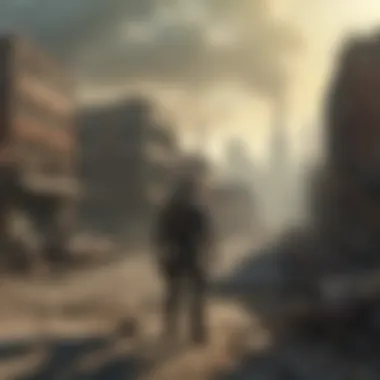

Character design serves as a critical element in the Fallout franchise, providing insight into the narrative, atmosphere, and motivations within the post-apocalyptic world. It encompasses the visual portrayal of characters, which acts as a bridge between the gamers and the immersively created universe. Thoughtful character design enhances storytelling by imparting personality, culture, and history through art, making the gameplay experience significantly richer. Understanding the evolution and influences on character design not only adds depth to the narrative but also fosters a connection between players and the characters they interact with.
Evolution of Key Characters
The evolution of key characters in Fallout showcases the adaptation and refinement of design practices over time. From the initial creations in Fallout 1 to the more sophisticated representations in Fallout 76, character features have continually matured. The iconic Vault Dweller establishes a foundation, characterized by the jumpsuit and distinctive Pip-Boy device. This character's simplicity resonated due to its relatability and everyman quality.
In contrast, characters like Lone Wanderer and Sole Survivor reveal a more diversified character palette that reflects changing player expectations. Development teams embraced the opportunity to explore deeper backgrounds, motivations, and relationships, resulting in more complex narratives around each character. This evolution is visible not only in their physical designs but also in their stories, emphasizing how character arcs can impact overall gameplay.
Concept Art vs. Final Designs
The distinction between concept art and final designs in Fallout is significant for a deeper understanding of the creative process. Concept art serves as the initial blueprint, allowing designers to experiment with various ideas before settling on the final product. For instance, early sketches of characters may present stark, exaggerated features that capture the essence of personality but may not translate directly into the game.
Once feedback is received, adjustments are made to create more relatable characters. This means integrating aspects that align with gameplay mechanics and visual consistency throughout the game. An interesting case is the design evolution of characters like Dogmeat. Initial concepts may differ remarkably from the final render but retain the core attributes that define the character within the game’s narrative.
Cultural Influences on Character Portrayal
Cultural influences play a pivotal role in the portrayal of characters in the Fallout series. Each character may represent broader themes relevant to society, from the implications of war and environmental disaster to the exploration of morality and survival. Characters are often shaped by contemporary issues, allowing players to make connections to real-world situations. Characters like Piper Wright tap into themes of investigation and truth-telling, reflecting the importance of media and journalism in any society.
Additionally, character designs often draw inspiration from various cultural references found throughout post-apocalyptic lore. Elements of Americana, from 1950s aesthetics to modern-day political commentary, manifest visually in characters. This integration of cultural influences enriches gameplay and offers insights into the societal commentary embedded in their designs.
"Character design in Fallout is not merely about visuals; it represents a complex interplay of narrative, culture, and player interaction that shapes the entire experience of the game."
In summary, character design in Fallout extends beyond aesthetics. The ongoing evolution of designs showcases the attention to detail in portraying complex characters driven by cultural narratives. This understanding enables players not only to appreciate the artistry but also to grasp the underlying themes and messages woven throughout the franchise.
Environment Design in Fallout
The environment design in Fallout is a crucial element that contributes to the immersive experience of the game. It encapsulates the narrative essence and time period, drawing players into a world ravaged by nuclear war. The details in the environment not only serve a functional purpose but also create emotional resonance. Through various visual cues, the environments tell stories of loss, resilience, and the remnants of a once-thriving civilization.
Iconic Locations and Their Visuals
Iconic locations in Fallout are not merely backdrops; they are pivotal to the storytelling. Each site is crafted with specific details that evoke a sense of place. For instance, locations like Megaton and Diamond City are rich in history and reflect the new societal constructs that emerged after the apocalypse.
- Megaton showcases a blend of pre-war architecture and post-war survivalist adaptations. The bomb in its center stands as a potent symbol of both destruction and a community’s perseverance.
- Diamond City, built atop the ruins of Fenway Park, combines vibrant vendor culture with the harsh realities of a wasteland.
The visual representation of these places informs players not just about their functions, but also about the cultures that have risen within them. Through careful layout and distinct design elements, players are encouraged to explore and engage with the world around them.
World-Building Through Art
Art in Fallout plays a fundamental role in world-building. Each piece of the environment invites players to interact and imagine the lives of those who inhabited the pre-apocalyptic world. For example, the presence of radio stations, shops, and shantytowns adds layers of authenticity and depth.
Every environmental asset, from derelict cars to crumbling buildings, communicates something about the history of the setting. The art direction emphasizes decay and resurgence.
Key features include:
- Environmental storytelling elements: Items like posters or old appliances provide context.
- Interaction points: Environmental features encourage players to uncover lore and engage with the backstory of areas.
This integration of art and design enhances player engagement and offers different narratives depending on where the player chooses to delve.
Comparison of Different Fallout Games
Comparing the environmental design across different Fallout games reveals an evolution in aesthetics and functionality. Each installment builds upon the lessons learned from its predecessors, creating a more detailed and engaging world.
- Fallout 3 set a strong foundation with its vast, open-world design that merged urban decay with natural overgrowth.
- Fallout New Vegas took this a step further by incorporating distinct styles influenced by its desert setting, showcasing a different approach to post-apocalyptic life.
- Fallout 4 pushed boundaries with more intricate designs and an emphasis on player choice in crafting environments, enabling players to create their own narrative spaces.
"The environments in Fallout serve as both a playground for exploration and a canvas for storytelling. Each section of the world is imbued with history waiting to be uncovered."
Environmental design in Fallout thus represents more than mere graphical showcases—it is central to crafting the emotional experience within this post-apocalyptic narrative, continually engaging players with its rich storytelling potential.
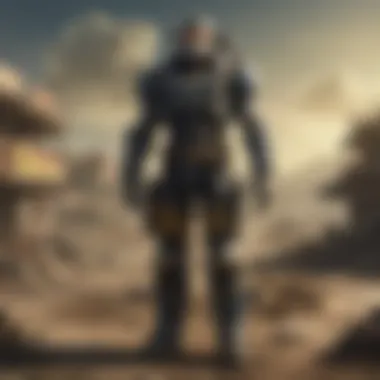

Artbooks as Narrative Devices
Artbooks serve as essential narrative devices within the realm of video games. They go beyond mere illustrations; they encapsulate the essence of the game’s story, mood, and conceptual vision. In the context of the Fallout artbook, the intricacies of its visual storytelling allow fans to explore the depth of its post-apocalyptic world. Artworks provide significant insights not just about the environments and characters, but about the entire narrative framework that defines the Fallout franchise.
Integrating Art with Storytelling
The integration of art and storytelling is particularly crucial in Fallout. The artwork in the artbook acts as a visual narrative, enhancing the understanding of the game’s lore. Illustrations convey major plot themes, character arcs, and emotional undertones that words alone may struggle to express.
For instance, concept art captures pivotal moments in the game that reflect the struggles and resilience of humanity in a worn-down world. Each piece is meticulously crafted to elevate the narrative experience. Fans can witness the evolution of environments from thriving pre-war settings to the stark decay of a post-nuclear landscape. This aspect engages players on a sensory level, cultivating a deeper connection with the game’s story.
Impact on Player Engagement
The Fallout artbook significantly impacts player engagement. By presenting curated artwork, it expands the universe, allowing players to further immerse themselves in its complexities. The visuals motivate players to engage both emotionally and intellectually. They provide motivation for exploration, encouraging players to discover the layers of story within the game.
The reception of fan art is another testament to this impact. It shows that the visual components resonate deeply with the community, inspiring them to contribute their interpretations. This exchange between the development team and community highlights a unique bond where art fuels creativity beyond the game itself.
"Art isn’t just what you see; it’s about what you feel."
The Fallout Community and Art Appreciation
The rich tapestry of the Fallout universe extends beyond just the games themselves; it is also deeply intertwined with its community. The appreciation of art in the Fallout franchise plays a pivotal role. The artbook serves not only as a collection of stunning visuals, but also as a bridge connecting fans to the deeper lore and artistic vision behind the series. This avocation for artistry cultivates a sense of belonging among fans, fostering discussion and collaboration. Through art, players are invited to delve into the history and emotion embedded within the post-apocalyptic landscape.
Fan Art and Its Influence
Fan art has emerged as a powerful platform within the Fallout community. It allows fans to express their interpretations, showcasing personal connections to characters, locations, and narratives. This form of artistic representation often draws inspiration directly from the original artbook, yet it expands the world in new and exciting ways.
Many talented artists contribute to the community by sharing their work on platforms like Reddit and Instagram. This not only democratizes the appreciation of art but also inspires further creativity. Fans may create art that reinterprets iconic scenes from the games, often suffused with personal experiences and emotions.
The influence of fan art extends to the official side as well. Developers may notice popular trends in fan interpretations, which can subtly affect future design choices. This fluid interaction exemplifies how community-generated content can help shape an ongoing narrative.
Art Exhibitions and Events
Art exhibitions dedicated to the Fallout franchise have become noteworthy events for enthusiasts. These exhibitions often feature curated selections from official artbooks alongside fan creations. They provide a tangible space for community members to come together, discuss their inspirations, and share experiences around shared interests.
Various conventions and meetups include showcases of works where artists can gather and connect with fans. Some exhibitions even highlight the integration of visual design with gameplay, offering insights into how art influences the gaming experience directly.
Such events also serve as natural forums for dialogue around the symbolism and themes present in Fallout art. By discussing the work in person, players can develop a greater appreciation for the intricate details that define the series. Current trends, such as eco-political themes or nostalgia, are explored in-depth, fostering a continual conversation about the essence of the universe.
At these gatherings, one sees firsthand the passion and creativity that fuel the Fallout community. The art appreciation transcends mere visuals, evolving into a shared experience that binds fans together.
In summary, the Fallout community’s appreciation for art is an essential aspect that enhances the overall experience. Through fan art and exhibitions, connections deepen and the narratives evolve, allowing players to engage more profoundly with the world that Bethesda has built. This culture of art appreciation ultimately shapes the legacy of the Fallout series, ensuring its place in both gaming and artistic communities.
Ending: The Legacy of the Fallout Artbook
The Fallout artbook stands as a testament to the creativity and artistic vision that defines the franchise. It is more than just a collection of visuals; it is a narrative archive that captures the essence of a post-apocalyptic world shaped by imagination and resilience. The artbook serves several important functions. Firstly, it showcases the intricate artistry that goes into the design of characters, environments, and overall aesthetics. Each page is a reminder of the journeys players undertake, the choices they make, and the stark realities of the worlds created.
Moreover, the artbook allows fans to appreciate the evolution of design principles across the various Fallout titles. This evolution is significant as it not only details key moments in the franchise but also reflects broader cultural themes and influences that have permeated the series over time. By exploring the book, players and enthusiasts can gain insights into the philosophy that guides the creation of the Fallout universe.
The Fallout artbook also acts as a bridge between the game and its community, fostering a sense of belonging and shared experience. It encourages fan engagement through inspiration for fan art, discussions on platforms like Reddit and Facebook, and participation in art exhibitions and events. Ultimately, the legacy of the Fallout artbook lies in its ability to galvanize the artistic community, enriching the ongoing dialogue between creators and fans.
Reflections on the Artistic Journey
The artistic journey of Fallout is marked by a mix of challenges and triumphs. Each installment has seen a growth in artistic ambition, from the early roots of the franchise to the modern representations that players experience today. This journey is worth reflecting on, as it highlights the dedication of artists who continue to innovate and push boundaries.
Over the years, Fallout has effectively blended various artistic styles, shaping its unique identity. It incorporates a mix of 1950s Americana, retro-futurism, and dystopian imagery. This blend is not merely aesthetic but is steeped in narrative purpose. The art tells stories of hope and despair, human resilience, and the consequences of choices made in the wake of devastation.
Fans often express how these visuals resonate with their experiences. The artbook captures those sentiments, offering fans a deeper understanding of design intentions. It also invites reflection on how these artistic aspects influence gameplay and narrative immersion.
Future of Fallout Art and Design
Looking forward, the future of Fallout art and design will likely continue to evolve in intriguing ways. With new technologies and platforms emerging, artists will have more tools at their disposal. Innovations in virtual reality and augmented reality could redefine how stories are told and experienced within the Fallout universe.
As the franchise continues, it is essential that it remains true to its core identity while exploring new artistic directions. Future artbooks will have the potential to document this progression, offering fans a glimpse into where the series may head next. The conversations between community and creators will only deepen, as the fan base grows and diversifies.
Furthermore, as cultural contexts shift, the themes explored in Fallout art could also reflect contemporary issues, providing poignant commentary on society. So, while the foundations are strong, the future art and design will weave new narratives that resonate with even broader audiences.
